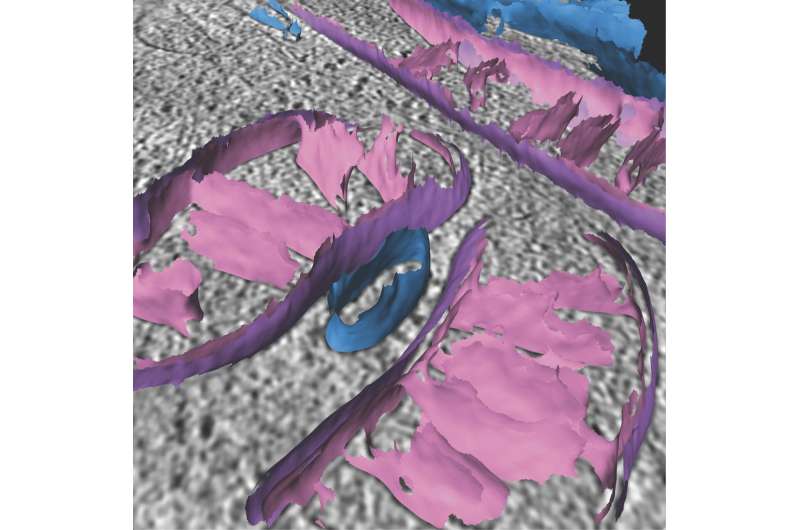The interior of a cell captured by cryo-electron tomography imaging and overlayed with three-dimensional reconstructions of mitochondrial inner (pink), outer (purple) and endoplasmic reticulum (blue) membrane surfaces. Credit: Scripps Research
An advanced imaging-based method from scientists at Scripps Research offers a new way of studying mitochondria.
In their report on February 14, 2023, in the Journal of Cell Biology, the scientists described a set of techniques that enables the imaging and quantification of even subtle structural changes inside mitochondria, and the correlation of those changes with other processes ongoing in cells.
Mitochondria are involved not only in energy production, but also in several other critical cellular functions, including cell division and cell-preserving responses to various types of stress. Mitochondrial dysfunctions have been observed in a host of diseases, including Alzheimer's, Parkinson's disease and different cancers, and researchers are eager to develop treatments that can reverse these dysfunctions. But the scientific tools for studying the fine details of mitochondria structure have been limited.
"We now have a powerful new toolkit for detecting and quantifying structural, and thus functional, differences in mitochondria—for example, in diseased versus healthy states," says study senior author Danielle Grotjahn, Ph.D., assistant professor in the Department of Integrative Structural and Computational Biology at Scripps Research.
The co-first authors of the study were Grotjahn lab members Benjamin Barad, Ph.D., a postdoctoral research associate, and Michaela Medina, a Ph.D. candidate.
Mitochondria are one of the many membrane-bound molecular machines, or "organelles," that dwell within the cells of plants and animals. Typically numbering in the hundreds to thousands per cell, mitochondria have their own small genomes, and have a distinctive structure with an outer membrane and a wavy inner membrane where key biochemical reactions occur. Scientists know that the appearances of mitochondrial structures can change dramatically depending on what the mitochondrion is doing, or what stresses are present in the cell. These structural changes therefore can be highly useful markers of cell conditions, though until now there hasn't been a good method for detecting and quantifying them.
In a new study, Scripps Research scientists describe new imaging techniques for studying mitochondria. Credit: Scripps Research
In the study, Grotjahn's team put together a computational toolkit to process imaging data from a microscopy technique called cryo-electron tomography (cryo-ET), which essentially images biological samples in three dimensions, using electrons instead of light. The researchers' "surface morphometrics toolkit," as they call it, enables the detailed mapping and measurement of the structural elements of individual mitochondria. This includes the bends of the inner membrane and the gaps between membranes—all potentially useful markers of important mitochondrial and cellular events.
"It allows us essentially to turn the beautiful 3D pictures of mitochondria we can get from cryo-ET into sensitive, quantitative measurements—which we can potentially use to help identify the detailed mechanisms of diseases, for example," Barad says.
The team demonstrated the toolkit by using it to map structural details on mitochondria when their cells were subjected to endoplasmic reticulum stress, a type of cell stress that is seen often in neurodegenerative diseases. They observed that key structural features such as the curvature of the inner membrane, or the minimum distance between inner and outer membranes, changed measurably when under this stress.
With their successful, proof-of-principle demonstrations of the new toolkit, the Grotjahn lab will now use it for studying in more detail how mitochondria respond to cellular stresses or other changes induced by diseases, toxins, infections and even pharmaceuticals.
"We can compare the effects on mitochondria in cells treated with a drug versus the effects on untreated mitochondria, for example," Medina says. "And this approach is not limited to mitochondria—we can also use it to study other organelles within cells."
"Quantifying organellar ultrastructure in cryo-electron tomography using a surface morphometrics pipeline," was co-authored by Benjamin Barad, Michaela Medina, Daniel Fuentes, Luke Wiseman and Danielle Grotjahn, all of Scripps Research.
More information: Benjamin A. Barad et al, Quantifying organellar ultrastructure in cryo-electron tomography using a surface morphometrics pipeline, Journal of Cell Biology (2023). DOI: 10.1083/jcb.202204093
Journal information: Journal of Cell Biology
Provided by The Scripps Research Institute
























